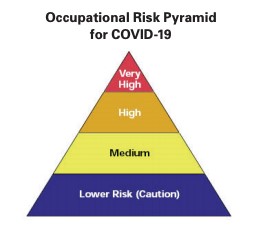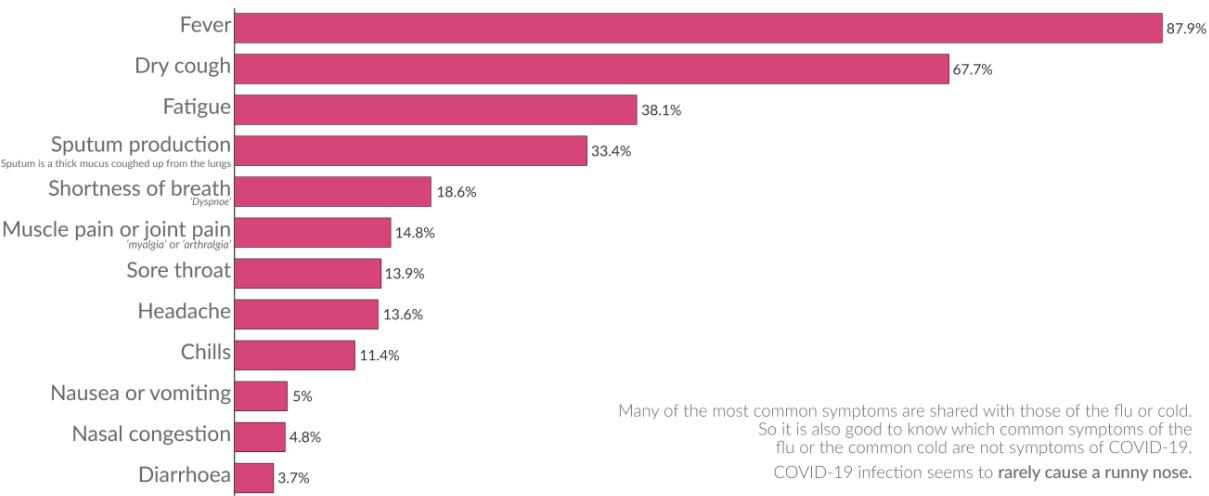As businesses plan for the return of workers, they should understand the regulatory landscape and create a proactive plan. If unprepared, employers risk exposure to workers comp., negligence, unfair labor, privacy, and discrimination claims (1). Where COVID-19 legal obligations end, moral obligations can help direct policies that keep employees safe and avert contentious situations.
What guidelines oversee an employer’s responsibility for protection of returning workers?
- Although OSHA has not created new requirements specific to COVID-19, its current guidelines should drive employers’ plans for employee safety. OSHA has created Guidance on Preparing Workplaces For COVID-19 which reinforces 4 levels of employee risk and the precautions for each.

- OSHA requires development of a response plan which should include awareness training, procedures for issuing PPE (if appropriate), surveillance & reporting protocols, maintain documentation and records, and use the OSHA 300 log to record illnesses that are work related. (2)
- Where threat of infection is a possibility, employers are required to provide PPE. Employees cannot demand specific PPE or PPE that is not appropriate to the threat.
- Employees that “don’t feel safe” have little basis to demand further protection if the employer is compliant with federal and state safety requirements. (3)
- In the event of an immediate threat, OSHA maintains that an employee can not be forced to return to the workplace. In addition, the National Labor Relations Act (NLRA) protects concerted activities by employers to refuse to work in unsafe working conditions. (3)
- Employees that develop the virus as a result of work exposure are entitled to disability benefits. Employers should review their workers compensation coverage benefits and any limits on occupational disease. Employees that develop COVID-19 from non-work related sources might be entitled to disability benefits if offered by the employer. (4)
- Employers with more than 50 employees are required to provide up to 12 weeks of unpaid leave for qualified employees who have a “serious health condition”. (4)
Steps to provide a safe work environment
- The CDC offers Mitigation Strategies for Communities based on the various threat levels of minimal, moderate or substantial.
- Review the CDC’s Interim Guidance for Businesses and Employers Responding to Coronavirus Disease 2019
- Conduct a thorough hazard assessment of the workplace
- Determine in what situations PPE is required, the appropriate style of PPE, provide the PPE at no cost to the employee and train the employees in its use.
- Know the symptoms of COVID-19 and remove employees who are displaying symptoms.

- Implement rules for social distancing. The CDC recommends 6 feet of separation (2 arm’s lengths), not to gather in groups, and to avoid crowded places.
- Wireless devices like those available from AiRISTA automatically alert users when the 6’ boundary is broken. The solution should report not only contacts but the duration of the contact and provide location information if deep cleaning is subsequently needed. Prepare a list of requirements as you evaluate vendors’ solutions.
- Implement flexible work hours or staggered shifts.
- Increase the physical space between employees with new workspace layouts and tape on the floor.
- Limit access to common areas.
- Prohibit handshakes.
- Create space between employees and customers including physical barriers like Plexiglas.
- Provide hand hygiene dispensers and encourage their use in regular employee communications. Hand hygiene monitoring systems like those offered by AiRISTA report levels of compliance where such reports are required like hospitals.
- Clean work surfaces in high-touch areas with approved disinfectants.
- Educate employees on protective measures they can take in the workplace and at home.
- Document these safety steps and communicate with employees on a regular basis.
A cornerstone to a well-documented COVID-19 preparedness plan is a living plan with frequent updates based on authoritative sources. Coordinate with state and local health authorities for the latest recommendations for your location. The regulatory landscape will continue to evolve and many areas will remain vague. Ultimately, it is the duty of the employer to provide a safe work environment. Dr. Megan Healy, Chief Workforce Development Adviser to the Governor of Virginia advises, “We’re really telling employers to do the right thing. You need to look out for the safety and health of your workers. There’s a liability to you knowing that there’s potential hazards in your workplace and you don’t do anything about it.”
Resources
CDC – www.cdc.gov
U.S. Department of Health & Human Services – www.flu.gov
OSHA – www.osha.gov
The World Health Organization – www.who.int
CDC Emergency Response Hotline for health employers – (770) 488-7100
(1) Harvard Business Review, “What are a Company’s Legal Obligations Around Coronavirus?”, May 4 2020
(2) “COVID-19 and the Workplace: Employer Obligations”, Torys LLP, March 13 2020
(3) Kiplinger, “COVID-19 at Work: Your Legal Rights and Responsibilities”, Dennis Beaver, April 29 2020
(4) “Coronavirus: Employer’s Liability Issues”, Seyfarth Shaw, LLP, Jan 29 2020





